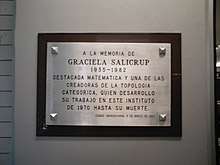Graciela Salicrup
| Graciela Salicrup López | |
|---|---|
 | |
| Born |
7 April 1935 Mexico City, Mexico |
| Died | 29 June 1982 (aged 47) |
| Nationality | Mexican |
| Occupation | Mathematician and architect |
Graciela Beatriz Salicrup López (7 April 1935 – 29 June 1982) was a Mexican architect, archaeologist and mathematician. In the 1970s and 1980s she was a pioneer in the field of categorical topology. Most of her work was published in Spanish, and her original contributions were not widely recognised until after her premature death.
Life
Graciela Beatriz Salicrup Lopez was born in Mexico City on 7 April 1935, and attended the Colegio Alemán for her primary education.[1] She was admitted to the Escuela Nacional Preparatoria for her secondary education, where she studied mathematics.[2] Her parents felt that Graciela's focus on her studies and extreme interest in mathematics might indicate a mental problem, and arranged for her to see a psychiatrist, Armando Hinojosa Cavazos. He became her husband, and they would have three children.[3]
Graciela attended the National Autonomous University of Mexico (UNAM), where she obtained a degree in architecture in 1959.[4] She participated in the excavations of Teotihuacan and worked on restoration of paintings and sites with the archaeologist Laurette Séjourné.[5] Married and with three children, she still wanted to become a mathematician, and finally enrolled in the Faculty of Sciences in 1964 to study mathematics. Between 1966 and 1968 she taught Mathematics at the UNAM Faculty of Architecture.[5] Her thesis, accepted in 1969, was on the Jiang Boju subgroup.[6]
After graduating in 1969 Graciela began teaching in the UNAM Faculty of Sciences. In 1970 she was given a position as a researcher in the UNAM Mathematics Institute, where she worked with Dr. Roberto Vázquez.[5] Graciela's work was concerned with the structure of the Top category of topological spaces and with continuous functions.[7] Her work related concepts such as reflexivity or correflexivity to those of connection and coexistence, both in Top and in certain subcategories of Top (and in some more general concrete categories).[6] The publications she co-authored with Vázquez were always in Spanish, so many mathematicians were not aware of her work.[5]

In the late 1970s Graciela and some fellow mathematicians arranged to take German lessons, since there was an important group of topologists writing in German, including Horst Herrlich.[2] Shortly before her death, Graciela fell out with Roberto Vázquez and they stopped collaborating. In the summer of 1982 she was visited by Lamar Bentley and Horst Herrlich, with whom she planned to collaborate Soon after this Graciela suffered a fall that hurt her badly. She did not recover, and died on 29 July 1982.[8] The main hall of the UNAM Institute of Mathematics is named after her.
Selected publications
Architecture
- Laurette Séjourné (May–June 1963), graphs of the percentages of different types of ceramics by Graciela, "La cerámica de Teotihuacán", Cuadernos Americanos
- Laurette Séjourné (September–October 1962), drawings by Abel Mendoza and Graciela, "Interpretación de un jeroglífico teotihuacano", Cuadernos Americanos
- Laurette Sejourné (1966), Arquitectura y pintura en Teotihacán, maps and perspectives by Graciela, México: Siglo XXI Editores
Mathematics
- Graciela Salicrup (1969), Subgrupo de Jiang-Bo-Ju (thesis), F. de Ciencias, UNAM .
- Graciela Salicrup; Roberto Vázquez (1970), "Fibraciones y correflexiones", Anales del Instituto de Matemáticas, UNAM
- Graciela Salicrup; Roberto Vázquez (1971), "Fibraciones y correflexiones II", Anales del Instituto de Matemáticas, UNAM
- Graciela Salicrup; Roberto Vázquez (1972), "Categor´ias de conexi´on", Anales del Instituto de Matemáticas, UNAM
- Graciela Salicrup; Roberto Vázquez (1973), "T-cocientes", Anales del Instituto de Matemáticas, UNAM
- Graciela Salicrup (1974), "Reflexividad y coconexidad en Top", Anales del Instituto de Matemáticas, UNAM
- Graciela Salicrup; Roberto Vázquez (1975), "Expansiones A-conexas y subespacos A-máximos", Anales del Instituto de Matemáticas, UNAM
- Graciela Salicrup; Roberto Vázquez (1975), "Objetos máximos en categorías de conexión de Top", Anales del Instituto de Matemáticas, UNAM
- Graciela Salicrup; Roberto Vázquez (1977), "On functors with quasi-small fibres", Anales del Instituto de Matemáticas, UNAM
- Graciela Salicrup (1978), "Epirreflexividad y conexidad en categorías concretas topológicas", Anales del Instituto de Matemáticas (doctoral thesis), UNAM
- Graciela Salicrup; Roberto Vázquezz; Horst Herrlich (1979), "Dispersed factorization structures", Canadian Journal of Mathematics (31)
- Graciela Salicrup; Roberto Vázquez; Horst Herrlich (1979), "Light factorization structures", Quaestiones Mathematicae
- Graciela Salicrup; Roberto Vázquez, (1979), Connection and disconnection, Lecture Notes in Mathematics, Springer
- Graciela Salicrup (1980), "Normal connection subcategories", Anales del Instituto de Matemáticas, UNAM
- Graciela Salicrup (1981), "Multirreflexividad y multicorreflexividad", Memorias SET
- Graciela Salicrup (1982), "Multiepireflective subcategories", Topology and its Applications, Elsevier
- Graciela Salicrup (1982), Local monocoreflectivity in topological categories, Lecture Notes in Mathematics, Springer
- Graciela Salicrup; Horst Herrlich; George Strecker (1986), "Factorizations, denseness, separation, and relatively compact objects", Proceedings of the 8th International Conference on Categorical Topology
Notes
- ↑ Gómez Wulschner 2007, p. 1.
- 1 2 Gómez Wulschner 2007, p. 2.
- ↑ Gómez Wulschner 2007, p. 3.
- ↑ Gómez Wulschner 2007, p. 5.
- 1 2 3 4 Gómez Wulschner 2007, p. 6.
- 1 2 Prieto 2007, p. 13.
- ↑ Prieto 2007, p. 3.
- ↑ Gómez Wulschner 2007, p. 8.
Sources
- Gómez Wulschner, Claudia (2007), "Ecos del pasado... luces del presente : Graciela Salicrup (1935-1982)", Miscelánea Matemática (in Spanish), 44, retrieved 2017-11-27
- Prieto, Carlos (June 2007), Graciela Salicrup, pionera de la Topología Categórica (in Spanish), Instituto de Matemáticas, Universidad Nacional Autónoma de México (UNAM), retrieved 2017-11-27